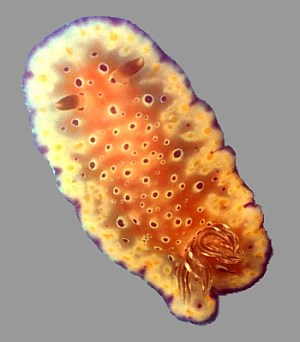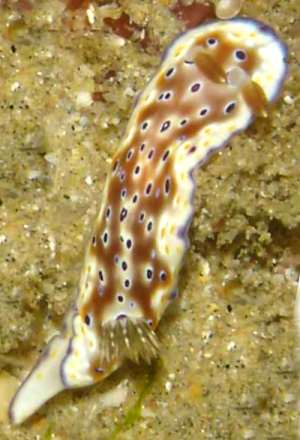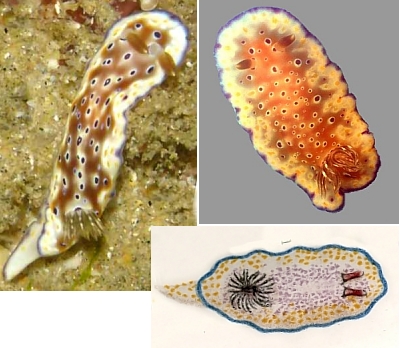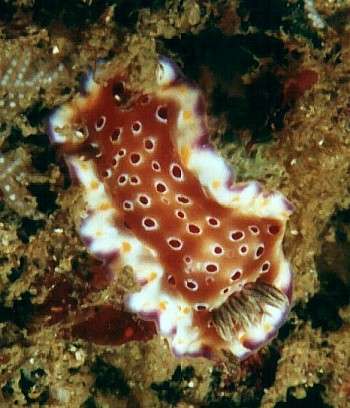
Chromodoris tennentana
(Kelaart, 1859)
Order: NUDIBRANCHIA
Suborder: DORIDINA
Superfamily: EUDORIDOIDEA
Family: Chromodorididae
DISTRIBUTION
East Africa, Sri Lanka.
PHOTO
Pangavini Is, Dar es Salaam, Tanzania, November 1976, 20mm long alive. PHOTO: Bill Rudman.
This species was reported from East Africa (Edmunds, 1971) and identified with Eliot's description of Chromodoris vicina Eliot, 1904, with which it agrees almost exactly. However there would appear an earlier name, Doris tennentana Kelaart, 1859, from Sri Lanka (Ceylon).
In specimens for Tanzania the underside is white with a marginal row of blackish purple spots and a submarginal row of yellow spots.
In a earlier publication (Rudman, 1987) I considered that Chromodoris cavae Eliot, 1904, was also a synonym of C. tennentana, but a photo sent to the Forum by Valda Fraser, from South Africa, show that it is a distinct species.
References:
• Edmunds, M. (1971) Opisthobranchiate Mollusca from Tanzania (Sub-Order: Doridacea. Zoological Journal of the Linnean Society, 50: 339-396.
• Eliot, C.N.E. (1904) On some nudibranchs from East Africa and Zanzibar. Part IV. Proceedings of the Zoological Society of London, (1904): 380-406.
• Rudman, W.B. (1987) The Chromodorididae (Opisthobranchia: Mollusca) of the Indo-West Pacific: Chromodoris epicuria, C. aureopurpurea, C. annulata, C. coi and Risbecia tryoni colour groups. Zoological Journal of the Linnean Society, 90: 305-407.
Rudman, W.B., 1999 (November 8) Chromodoris tennentana (Kelaart, 1859). [In] Sea Slug Forum. Australian Museum, Sydney. Available from http://www.seaslugforum.net/find/chrotenn
Related messages
Chromodoris tennentana from South Africa
May 4, 2007
From: Colin Ogden

Hi Bill.
Is this a Risbecia tryoni? All photos I have seen do not show the yellow spots below the mantle as reflected on this nudi. This one was also on its own without the normal mate!
Locality: Sodwana Bay, South Africa, Indian Ocean. Depth: 19 mts. Length: 30 mm. 04 June 2005. Coral reef. Photographer: Colin Ogden
Regards
Colin
scubaco@iafrica.com
Ogden C M, 2007 (May 4) Chromodoris tennentana from South Africa. [Message in] Sea Slug Forum. Australian Museum, Sydney. Available from http://www.seaslugforum.net/find/13967Dear Colin,
I am afraid this nice photo of Chromodoris tennentana has been languishing in the backlog of messages for too long. Your animal looks almost identical to a painting of a chromodorid from east Africa which Eliot named Chromodoris cavae. and which I later (Rudman, 1987) considered to be the same as C. tennentana. Much later, on the basis of a photo from Valda Fraser on the Forum [message #1521], I realised that they were indeed different. As numerous recent messages seem to show, C. cavae is very variable in colour, but there is one colour form which looks very similar to Chromodoris tennentana. Your animal is C. tennentana.
One obvious difference between the two species is the colour of the gills and rhinophores, in C. cavae they are white with purple tips, while in C. tennetana the rhinophores are reddish brown with a white tip and the gills are dark brown, sometimes with white spots. The gills and rhinophores in your animal are clearly those of C. tennentana. Another interesting feature of the colour pattern in your animal are the white spots in the centre of some of the dark purple spots. Eliot (1904) in his description of C. vicina from Zanzibar, which I consider to be a synonym of C. tennentana, specifically mentions that the larger violet spots have a white centre.
These white spots also indicate that this species may be related to the western Pacific species C. collingwoodi, which in specimens from Hong Kong [message #4802], can have similar white spots within the purple spots.
This is a valuable contribution to sorting out this group of species.
Best wishes,
Bill Rudman
Chromodoris tennentana and C. vicina
May 4, 2007
From: Bill Rudman

To accompany the many messages sent recently to the Forum about the variably coloured Chromodoris cavae, I though it worthwhile to summarise our understanding of C. tennentana, because one colour form of C. cavae, can easily be confused with C. tennentana.
Upper left: Sodwana Bay, South Africa, Indian Ocean. Length: 30 mm. 04 June 2005. Coral reef. Photographer: Colin Ogden [message #13967]. Upper right: Pangavini Is, Dar es Salaam, Tanzania, November 1976, 20 mm long alive. Photo: Bill Rudman. Lower right: Doris tennentana Kelaart, 1859. Kelaart's original painting of living animal published by Eliot (1906: Pl.XLIII fig. 1).
This species was first described Kelaart (1859) from Sri Lanka (Ceylon) as Doris tennentana. Kelaart was one of the first naturalists to describe tropical nudibranchs from the tropical Indian Ocean and although his description were brief, most have proven accurate enough, with the help of his published paintings, to identify his species. Although no mention is made of the orange-brown background, the distinctive colour of the gills and rhinophores can be seen in the painting, and the rhinophores are described as 'purplish red tipped with white. Also in the painting we can see a blue edge to the rhinophore pockets which are present in the photo of the Sth African specimen.
Doris tennentana Kelaart, 1859
"Mantle white with a faint bluish shade and spengles with golden-coloured and purple spots. margin caerulean blue. Dorsal tentacles clavate, purplish red, tipped with white, laminate. barchial plumes red, numerous, 12 to 15, linear, bipinnated. Foot white, upper surface spotted with yellow .... Under surface of mantle white, with bluish reflexions"
Charles Eliot (1904) described both Chromodoris vicina and C. cavae, but unfortunately the description of C. vicina was not accompanied by a colour illustration. However the description of the living animal is quite adequate for identification and matches both the photos from South Africa and Tanzania. Of particular interest is Eliot's mention of a white spot in some of the larger dark spots on the mantle, which can be seen in the upper left photo. Edmunds (1971) reported this species again from east Africa as Chromodoris vicina.
Chromodoris vicina Eliot 1904
Twelve specimens from Chuaka, Zanzibar - colour note of living animals:
"Mantle and foot bordered with light violet, the latter border a row of dots. Middle of back drab brown with bright violet spots, the larger ones with a white centre. Near the edge of the mantle a number of yellow spots with white borders, which are often confluent. The foot deep and narrow, white with some yellow spots near the lower edge. The rhinophores dark brown with white tips. Each of the branchiae bore two black bands"
In a earlier publication (Rudman, 1987) I considered that Chromodoris cavae Eliot, 1904, was also a synonym of C. tennentana, but numerous photos on the Forum of C. cavae show that it is a distinct species.
In brief, C. tennentana is a translucent creamy white with a mottled orange to brownish patch covering the central part of the mantle. On the brownish patch are scattered dark purple spots of variable size, some of which have a central white spot. Each purple spot is ringed with white. Between the brownish patch and the mantle edge are scattered yellow spots which can also be ringed with white. There is a watery purple band around the mantle edge, with some darker patches arranged evenly around the edge, and extending into the creamy white of the outer mantle. The sides of the body and foot are also creamy white with some large purple spots, ringed with white, on the sides of the body and smaller yellow spots near the edge of the foot. The foot is edged with watery purple band which can be broken into a series of spots.
There are many species with purple or purple and yellow spots, some of which I have discussed as the 'Risbecia tryoni colour group' and others as the C. aureopurpurea group. Of particular interest to any discussion of C. tennentana is the Indo-West Pacific species C. collingwoodi which has colour forms which are very similar, suggesting it is almost certainly a geographic sister species.
-
Edmunds, M. (1971) Opisthobranchiate Mollusca from Tanzania (Sub-Order: Doridacea. Zoological Journal of the Linnean Society, 50: 339-396.
-
Eliot, C.N.E. (1904) On some nudibranchs from East Africa and Zanzibar. Part IV. Proceedings of the Zoological Society of London, (1904): 380-406.
-
Eliot, C.N.E. (1906): On the nudibranchs of Southern India and Ceylon, with special reference to the drawings by Kelaart and the collections belonging to Alder & Hancock preserved in the Hancock Museum at Newcastle-on-Tyne. Proceedings of the Zoological Society of London for 1906, 2, 636-691. (Pls. 42-47)
-
Eliot, C.N.E. (1906) On the nudibranchs of Southern India and Ceylon, with special reference to the drawings by Kelaart and the collections belonging to Alder and Hancock, preserved in the Hancock Museum at Newcastle-on-Tyne, No. 2. Proceedings of the Zoological Society of London for 1906, 999-1008.
-
Kelaart, E.F. (1859) On some additional species of nudibranchiate Mollusks from Ceylon. Annals & Magazine of Natural History, IV: 267-270.
-
Rudman, W.B. (1984) The Chromodorididae (Opisthobranchia: Mollusca) of the Indo-West Pacific: a review of the genera. Zoological Journal of the Linnean Society 81: 115-273.
-
Rudman, W.B. (1987) The Chromodorididae (Opisthobranchia: Mollusca) of the Indo-West Pacific: Chromodoris epicuria, C. aureopurpurea, C. annulata, C. coi and Risbecia tryoni colour groups. Zoological Journal of the Linnean Society 90: 305-407.
-
Rudman, W.B. (1987) The Chromodorididae (Opisthobranchia: Mollusca) of the Indo-West Pacific: Chromodoris epicuria, C. aureopurpurea, C. annulata, C. coi and Risbecia tryoni colour groups. Zoological Journal of the Linnean Society, 90: 305-407.
Real Chromodoris tennentana from Sth Africa
November 13, 1999
From: Valda Fraser

Dear Bill
Thank you for your input. However, I now know that the image I sent you is
definitely not Chromodoris tennentana. I have come to this conclusion with reference to your illustration. Chromodoris tennentana also occurs in our area. The difference between the two specimens is quite apparent. Firstly, the colouration is different. C. tennentana has deep blue spots clearly outlined with white, all over its body. Chromodoris sp? has only a few spots. In addition, C. tennentana has a body structure with a flat profile. I include an image of C. tennentana. As you can see, it seems to stick to the reef like a worm. Chromodoris sp? has a raised body and moves in a different way.
Locality: South Coast KwaZulu/Natal - SOUTH AFRICA. Near Port Shepstone, 20 - 25m, October 1999. Size: 35mm
What else could it be?
Regards
Valda Fraser
iti04937@mweb.co.za
Fraser, V., 1999 (Nov 13) Real Chromodoris tennentana from Sth Africa. [Message in] Sea Slug Forum. Australian Museum, Sydney. Available from http://www.seaslugforum.net/find/1521Note added 4 May 2007: As can be seen by the discussions and many messages on C. cavae, I was quite wrong to identify this animal as that species. It is, as Valda suggested, a form of C. tennentana [see message #19875] - Bill Rudman.
Dear Valda,
I knew your original photo reminded me of something so I went back to my East African notes and found the answer. Your animal is almost certainly Eliot's Chromodoris cavae which has never been recorded again since it was described from Zanzibar in 1904. When I reviewed these animals (Rudman, 1987) I decided that C. cavae was probably just a bad color painting of C. tennentana. But on comparing the painting with your photo, I'm fairly convinced they are different.
This is quite an exciting find, and means we can take C. cavae off the 'never seen again' list. Eventually its anatomy will need to be looked at but I think you can confidently start calling it C. cavae.
Best wishes,
Bill Rudman.
